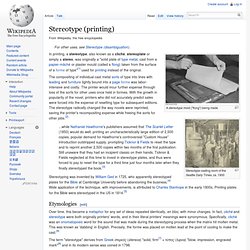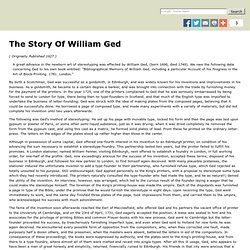

A biographical dictionary of eminent Scotsmen - Thomas Thomson. WILLIAM GED (1690-1749) - Online Information article about WILLIAM GED (1690-1749) Stereotype (printing) A stereotype mold ("flong") being made Stereotype casting room of the Seattle Daily Times, ca. 1900 In printing, a stereotype, also known as a cliché, stereoplate or simply a stereo, was originally a "solid plate of type metal, cast from a papier-mâché or plaster mould (called a flong) taken from the surface of a forme of type"[1] used for printing instead of the original.

William Ged - Stereotyping. William Ged (Scottish goldsmith. Overview of William Ged. History Of Stereotyping - The Story Of William Ged. ( Originally Published 1927 ) A great advance in the newborn art of stereotyping was effected by William Ged, (born 1690, died 1749).

We owe the following data concerning Ged to his own book entitled: "Bibliographical Memoirs of William Ged, including a particular Account of his Progress in the Art of Block-Printing. 1781. London. " By birth a Scotchman, Ged was successful as a goldsmith, in Edinburgh, and was widely known for his inventions and improvements in his business. William Ged - Encyclopedia. William Ged.
Ged was born in Edinburgh, where he carried on business as a goldsmith.

In 1729 he endeavoured to push his new process of printing, on which he had been working since 1725, in London by joining in partnership with a capitalist, but, disappointed in his workmen and his partner, he returned despondent to Edinburgh. An edition of Sallust and two prayer-books (for the University of Cambridge) were stereotyped by him.